A Holistic Concept to Design Optimal Water Supply Infrastructures for Informal Settlements Using Remote Sensing Data
Abstract
:1. Introduction
2. Materials and Methods
2.1. Remote Sensing, Slum Identification and Test Sites
2.2. Cost Model
3. Theory and Calculation
3.1. Introduction to Optimization and Technical Operations Research
3.2. Basics of Discrete Optimization
3.3. Developed Optimization Model
3.3.1. What Is the Task?
3.3.2. What Is the Objective?
3.3.3. What Are the Degrees of Freedom?
3.3.4. Optimize!
4. Results
4.1. Optimal Water Supply for Two Cities
4.2. Impact of Time
4.3. Impact of Varying Population Densities
4.4. Impact of Varying Resolution
4.5. Geographic Barriers
4.6. Impact of Varying Calculation Periods
5. Discussion of Optimization Results
6. Summary and Outlook
Acknowledgments
Author Contributions
Conflicts of Interest
Abbreviations
| DFG | German Research Foundation |
| FST | (Chair of) Fluid Systems |
| GMPL | GNU MathProg modeling language |
| MILP | Mixed integer linear program |
| MIP | Mixed integer problem |
| TOR | Technical operations research |
| UN | United Nations |
| VHR | Very high resolution |
| VGI | Volunteered geographic information |
| WW | Waterworks |
Appendix A. Water Supply Design via MILP
| Parameter | Description |
|---|---|
| N | Set of all slums, |
| Set of slums and waterworks w, | |
| Set of available pipe types with different diameters | |
| Volume flow capacity of pipes of type | |
| Fixed pipe costs of type , with length equal to distance from slum i to slum j | |
| Variable pipe cost factor of type | |
| Set of available truck types | |
| Volume flow capacity of truck of type | |
| Truck cost of type for distance from i to j | |
| Maximal number of trucks allowed between two slums | |
| Set of available tank types | |
| Capacity of tank of type | |
| Tank cost for type | |
| Daily water need in slum i | |
| Sum of daily water needs over all slums, | |
| Grid point set for linearization of cubic volume flow | |
| Volume flow at linearization grid points | |
| Cubic volume flow at linearization grid points | |
| Binary indicator if connection on is forbidden for pipe of type k due to geographic barriers | |
| Binary indicator if connection on is forbidden for truck of type k due to geographic barriers |
| Variable | Description |
|---|---|
| Binary indicator if any connection is chosen on | |
| Binary indicator if pipe of type k is chosen on | |
| Number of trucks of type k chosen on | |
| Number of tanks of type k chosen in i | |
| Total volume flow on | |
| Volume flow in pipes on | |
| Volume flow carried by trucks on | |
| Cubic volume flow approximated by piecewise linearization on , | |
| Volume flow carried out of i by trucks | |
| Volume flow carried into i by trucks and and out of i via pipes | |
| Volume flow carried into i by trucks and used in slum i | |
| Volume flow carried into i via pipe but not out of i via pipe | |
| Binary auxiliary variable for modeling maximum relation | |
| Auxiliary variable in of grid point to linearize cubic volume flow on for pipe type k | |
| Binary auxiliary variable for grid point to linearize cubic volume flow on for pipe type k |
Objective Function
Constraints
References
- United Nations. Sustainable Development Goals—17 Goals to Transform Our World. Available online: sustainabledevelopment.un.org/?menu=1300 (accessed on 27 July 2017).
- Unicef. WASH—Water, Sanitation and Hygiene. Available online: unicef.org/wash/ (accessed on 27 July 2017).
- United Nations. Sustainable Development Goals: Goal 6—Ensure Access to Water and Sanitation for All. Available online: un.org/sustainabledevelopment/water-and-sanitation/ (accessed on 27 July 2017).
- United Nations Human Settlements Programme (UN-HABITAT). World Cities Report 2016: Urbanization and Development—Emerging Futures; UN-Habitat: Nairobi, Kenya, 2016. [Google Scholar]
- Kuffer, M.; Pfeffer, K.; Sliuzas, R. Slums from Space—15 Years of Slum Mapping Using Remote Sensing. Remote Sens. 2016, 8, 455. [Google Scholar] [CrossRef]
- United Nations Human Settlements Programme. Background Paper: World Habitat Day—Voices from Slums; UN-Habitat: Nairobi, Kenya, 2014. [Google Scholar]
- Kit, O.; Lüdeke, M. Automated detection of slum area change in Hyderabad, India using multitemporal satellite imagery. ISPRS J. Photogramm. Remote Sens. 2013, 83, 130–137. [Google Scholar] [CrossRef]
- Mahabir, R.; Crooks, A.; Croitoru, A.; Agouris, P. The study of slums as social and physical constructs: Challenges and emerging research opportunities. Reg. Stud. Reg. Sci. 2016, 3, 399–419. [Google Scholar] [CrossRef]
- Lucci, P.; Bhatkal, T.; Khan, A. Are We Underestimating Urban Poverty; Overseas Development Institute: London, UK, 2016. [Google Scholar]
- Hofmann, P.; Taubenböck, H.; Werthmann, C. Monitoring and modelling of informal settlements—A review on recent developments and challenges. In Proceedings of the 2015 Joint Urban Remote Sensing Event (JURSE), Lausanne, Switzerland, 30 March–1 April 2015; pp. 1–4. [Google Scholar]
- Gruebner, O.; Sachs, J.; Nockert, A.; Frings, M.; Khan, M.M.H.; Lakes, T.; Hostert, P. Mapping the Slums of Dhaka from 2006 to 2010. Dataset Pap. Sci. 2014, 2014. [Google Scholar] [CrossRef]
- Taubenböck, H.; Esch, T.; Felbier, A.; Wiesner, M.; Roth, A.; Dech, S. Monitoring urbanization in mega cities from space. Remote Sens. Environ. 2012, 117, 162–176. [Google Scholar] [CrossRef]
- Taubenböck, H.; Kraff, N.J. Das globale Gesicht urbaner Armut? Siedlungsstrukturen in Slums. In Globale Urbanisierung; Springer: Berlin, Germany, 2015; pp. 107–119. [Google Scholar]
- Pesaresi, M. Texture analysis for urban pattern recognition using fine-resolution panchromatic satellite imagery. Geogr. Environ. Model. 2000, 4, 43–63. [Google Scholar] [CrossRef]
- Jacobsen, K.; Büyüksalih, G. Topographic mapping from space. In Proceedings of the 4th Workshop of EARSeL on Remote Sensing for Developing Countries/GISDECO, Istanbul, Turkey, 4–7 June 2008; pp. 4–7. [Google Scholar]
- Sliuzas, R. Dar Es Salaam Land Use and Informal Settlement Data Set; NASA Socioeconomic Data and Applications Center (SEDAC): Palisades, NY, USA, 2016. [Google Scholar]
- The MathWorks, Inc. MATLAB. Natick, Massachusetts, United States. Available online: mathworks.com/products/matlab.html (accessed on 29 January 2018).
- Veljanovski, T.; Kanjir, U.; Pehani, P.; Oštir, K.; Kovačič, P. Object-based image analysis of VHR satellite imagery for population estimation in informal settlement Kibera-Nairobi, Kenya. In Remote Sensing-Applications; InTech: Rijeka, Croatia, 2012. [Google Scholar]
- Taubenböck, H.; Wurm, M. Ich weiss, dass ich nichts weiss—Bevölkerungsschätzung in der Megacity Mumbai. In Globale Urbanisierung; Taubenböck, H., Wurm, M., Esch, T., Dech, S., Eds.; Springer: Berlin/Heidelberg, Germany, 2015; pp. 171–178. [Google Scholar]
- OpenStreetMap. Open Data, Licensed under the Open Data Commons Open Database License (ODbL) by the OpenStreetMap Foundation (OSMF). Available online: openstreetmap.org (accessed on 3 January 2018).
- MapKibera Trust. MapKibera Interactive Community Information Project. Available online: mapkibera.org/ (accessed on 3 January 2018).
- Mahabir, R.; Stefanidis, A.; Croitoru, A.; Crooks, A.T.; Agouris, P. Authoritative and volunteered geographical information in a developing country: A comparative case study of road datasets in Nairobi, Kenya. ISPRS Int. J. Geo-Inf. 2017, 6, 24. [Google Scholar] [CrossRef]
- Hachmann, S.; Arsanjani, J.J.; Vaz, E. Spatial data for slum upgrading: Volunteered Geographic Information and the role of citizen science. Habitat Int. 2017. [Google Scholar] [CrossRef]
- Krumke, S.O.; Noltemeier, H. Graphentheoretische Konzepte und Algorithmen; Springer: Berlin, Germany, 2012; Volume 3. [Google Scholar]
- Marchionni, V.; Cabral, M.; Amado, C.; Covas, D. Water supply infrastructure cost modelling. Procedia Eng. 2015, 119, 168–173. [Google Scholar] [CrossRef]
- Rüther, H.; Martine, H.M.; Mtalo, E. Application of snakes and dynamic programming optimisation technique in modeling of buildings in informal settlement areas. ISPRS J. Photogramm. Remote Sens. 2002, 56, 269–282. [Google Scholar] [CrossRef]
- Gürcke, R.; Goetzelmann, T.; Brenner, C.; Sester, M. Aggregation of LoD 1 building models as an optimization problem. ISPRS J. Photogramm. Remote Sens. 2011, 66, 209–222. [Google Scholar] [CrossRef]
- Pelz, P.F.; Lorenz, U.; Ludwig, G. Besser Geht’s Nicht. TOR Plant das Energetisch Optimale Fluidsystem. Chemie and More 2014. Available online: wl.fst.tu-darmstadt.de/wl/publications/article_140101_chemie_and_more_Besser_gehts_nicht_TOR_plant_das_energetisch_optimale_Fluidsystem_Lorenz_Pelz_Ludwig.pdf (accessed on 3 January 2018).
- Pöttgen, P.; Ederer, T.; Altherr, L.C.; Lorenz, U.; Pelz, P.F. Examination and Optimization of a Heating Circuit for Energy-Efficient Buildings. Energy Technol. 2015, 4, 136–144. [Google Scholar] [CrossRef]
- Schänzle, C.; Altherr, L.C.; Ederer, T.; Lorenz, U.; Pelz, P.F. As Good As It Can Be—Ventilation System Design By A Combined Scaling And Discrete Optimization Method. In Proceedings of the FAN 2015, Lyon, France, 15–17 April 2015. [Google Scholar]
- Rausch, L.; Leise, P.; Ederer, T.; Altherr, L.C.; Pelz, P.F. A comparison of MILP and MINLP solver performance on the example of a drinking water supply system design problem. In Proceedings of the European Congress on Computational Methods in Applied Sciences and Engineering, Crete Island, Greece, 5–10 June 2016. [Google Scholar]
- Pochet, Y.; Wolsey, L.A. Production Planning by Mixed Integer Programming; Springer Science & Business Media: Berlin, Germany, 2006. [Google Scholar]
- Kliewer, N.; Taieb, M.; Suhl, L. A time–space network based exact optimization model for multi-depot bus scheduling. Eur. J. Oper. Res. 2006, 175, 1616–1627. [Google Scholar] [CrossRef]
- Altherr, L.C.; Ederer, T.; Lorenz, U.; Pelz, P.F.; Pöttgen, P. Experimental Validation of an Enhanced System Synthesis Approach. Operations Research Proceedings 2014: Selected Papers of the Annual International Conference of the German Operations Research Society (GOR); Springer: Cham, Switzerland, 2015. [Google Scholar]
- Altherr, L.C.; Ederer, T.; Schänzle, C.; Lorenz, U.; Pelz, P.F. Algorithmic System Design Using Scaling and Affinity Laws. Operations Research Proceedings 2015: Selected Papers of the Annual International Conference of the German Operations Research Society (GOR); Springer: Cham, Switzerland, 2016. [Google Scholar]
- Schrijver, A. Theory of Linear and Integer Programming; John Wiley & Sons: Hoboken, NJ, USA, 1998. [Google Scholar]
- IBM. ILOG CPLEX Optimizer. Available online: ibm.com/software/commerce/optimization/cplex-optimizer/ (accessed on 27 July 2017).
- Gurobi. Gurobi Optimizer. Available online: gurobi.com/index (accessed on 27 July 2017).
- Vielma, J.P.; Ahmed, S.; Nemhauser, G. Mixed-integer models for nonseparable piecewise-linear optimization: unifying framework and extensions. Oper. Res. 2010, 58, 303–315. [Google Scholar] [CrossRef]
- Suhl, L.; Mellouli, T. Optimierungssysteme: Modelle, Verfahren, Software, Anwendungen; Springer: Berlin, Germany, 2013. [Google Scholar]
- GNU FreeSoftwareFoundation. GMPL (GNU MathProg Modeling Language). Available online: gnu.org/software/glpk/glpk.html (accessed on 27 July 2017).
- Kappes, A. Engineering Graph Clustering Algorithms. Ph.D. Thesis, Karlsruher Instituts für Technologie, Karlsruher, Germany, 28 April 2015. Available online: publikationen.bibliothek.kit.edu/1000049269 (accessed on 27 July 2017).
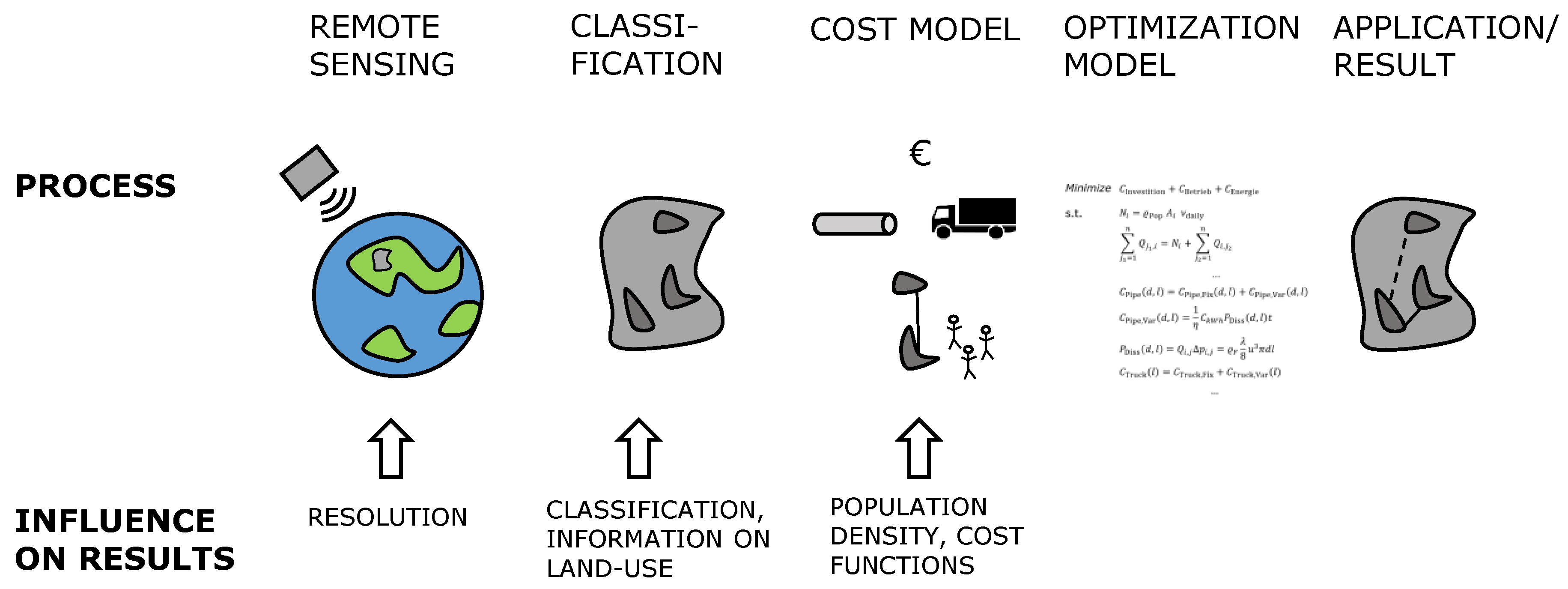


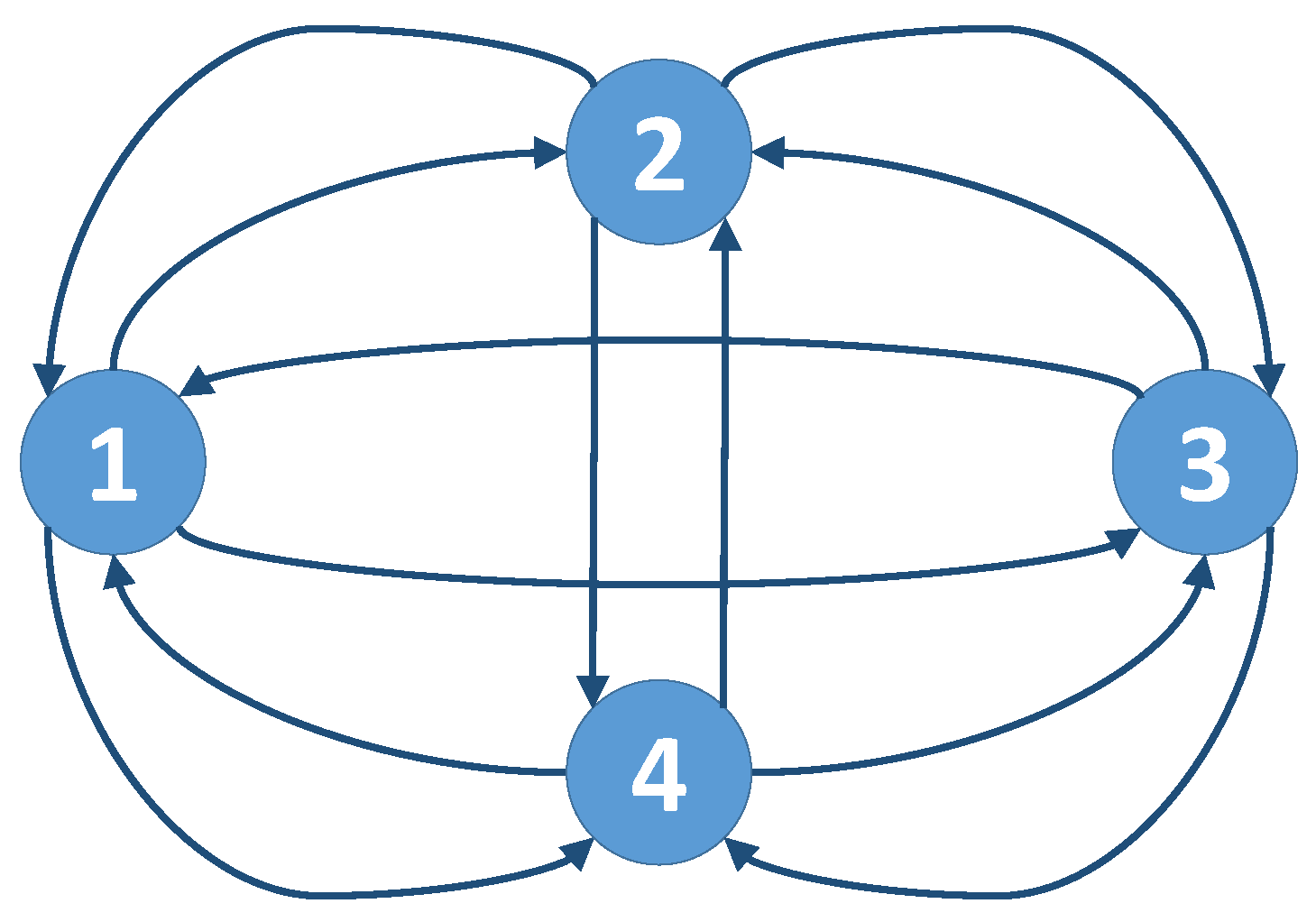
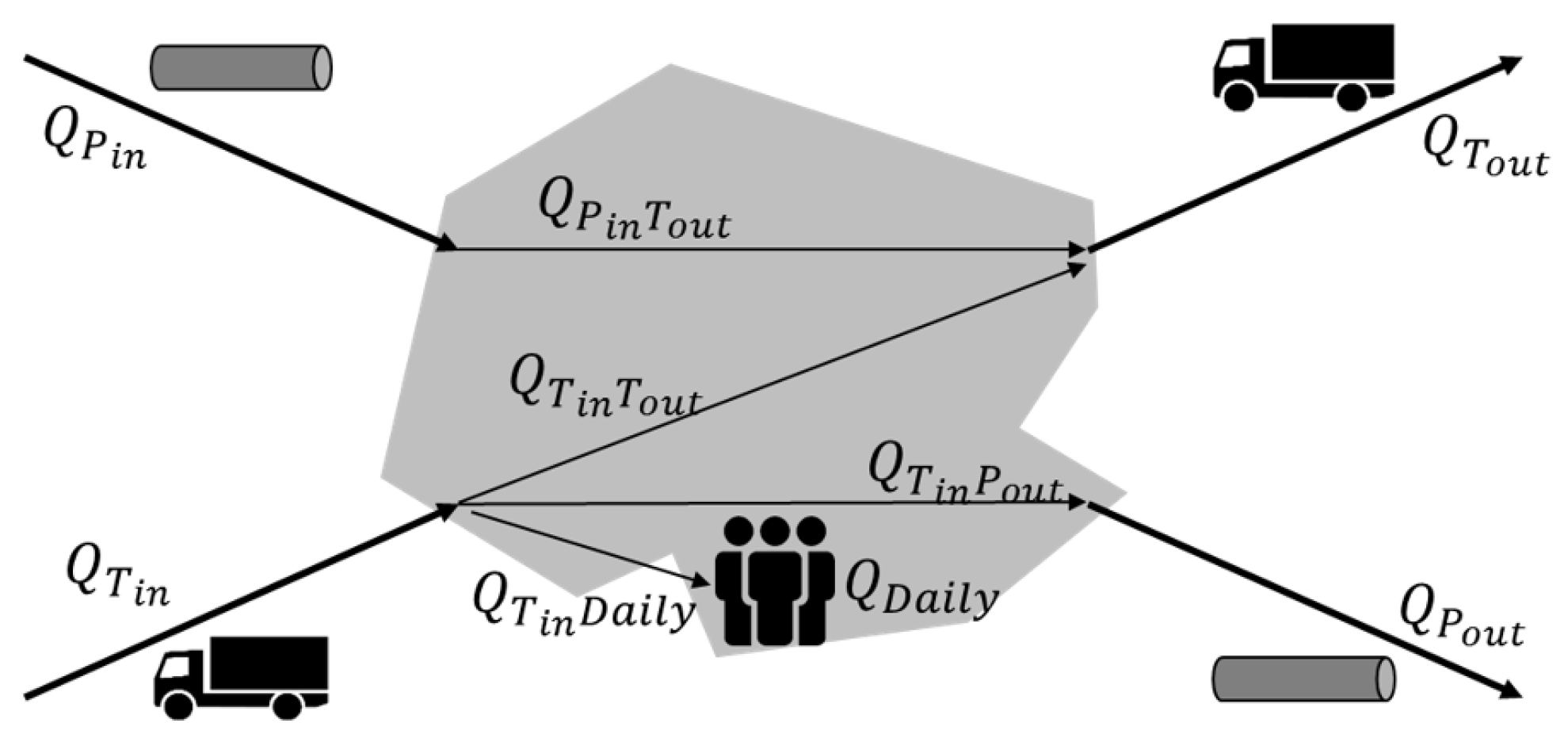
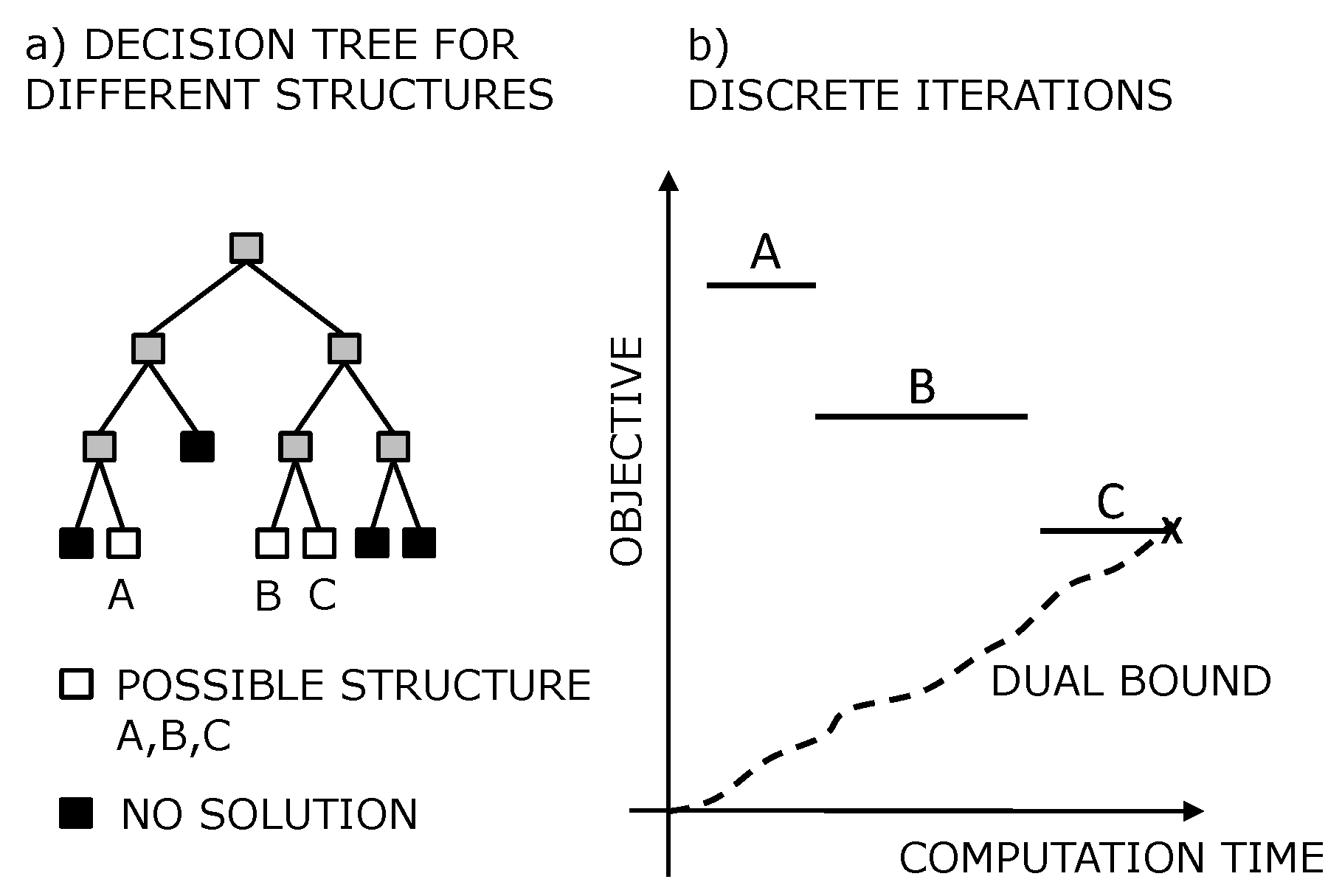

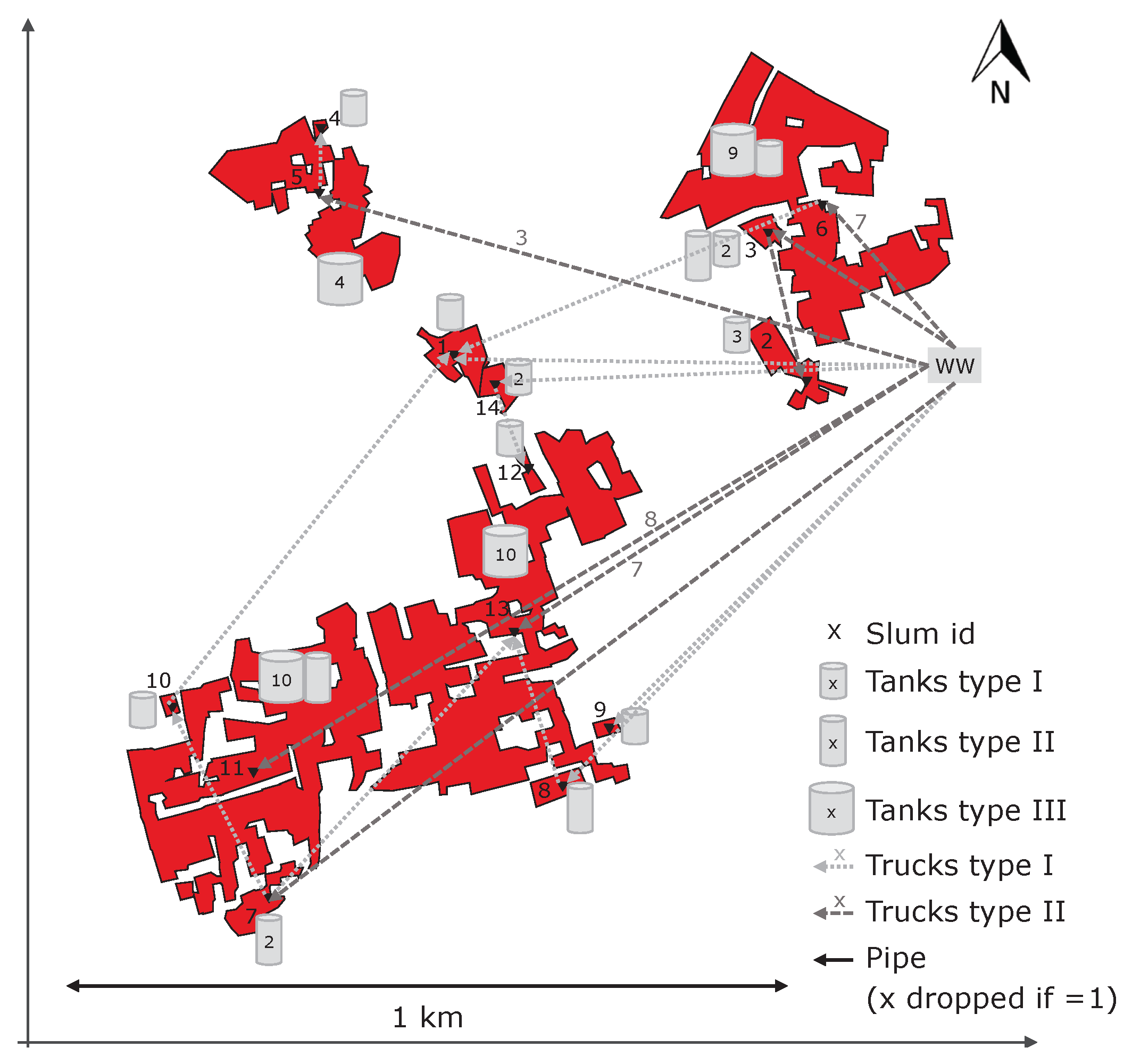
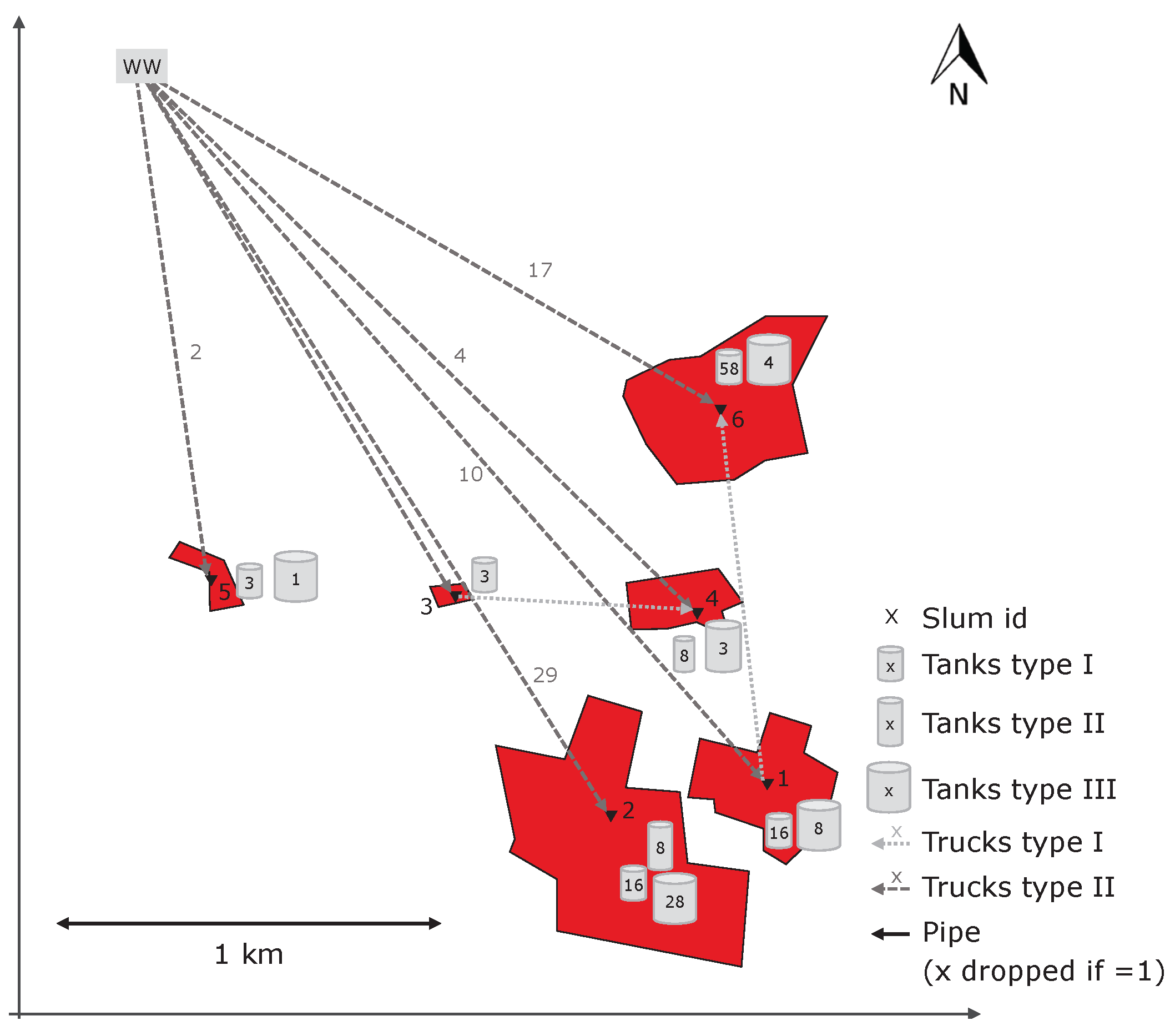
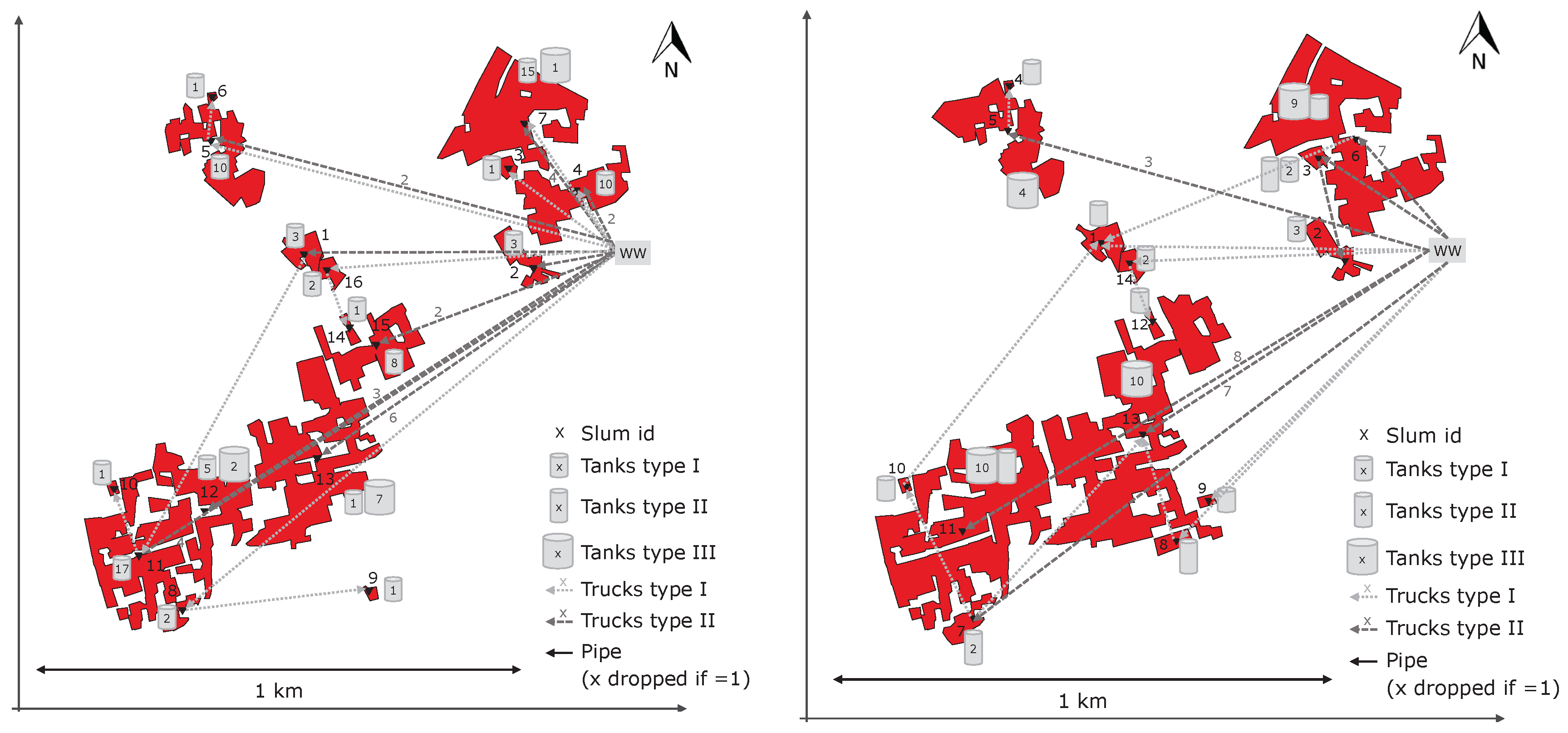
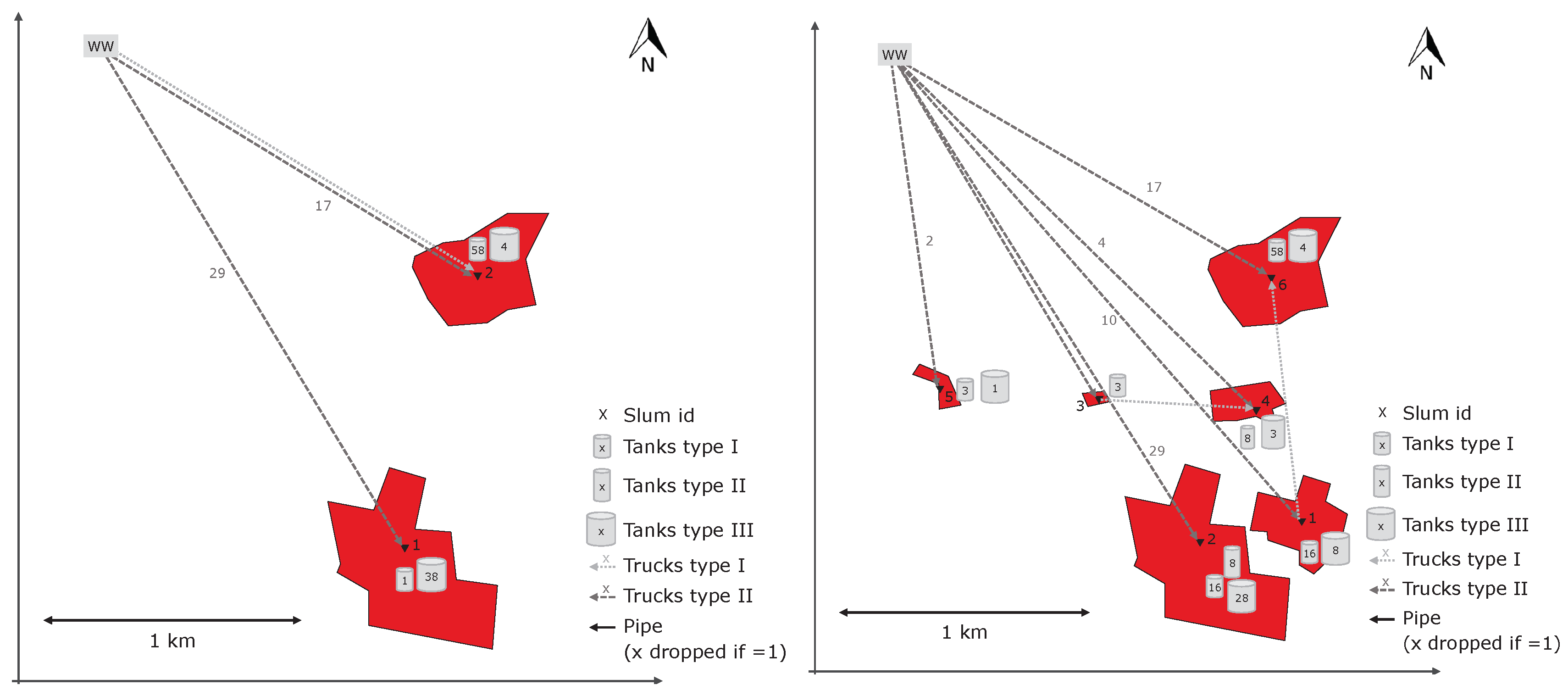

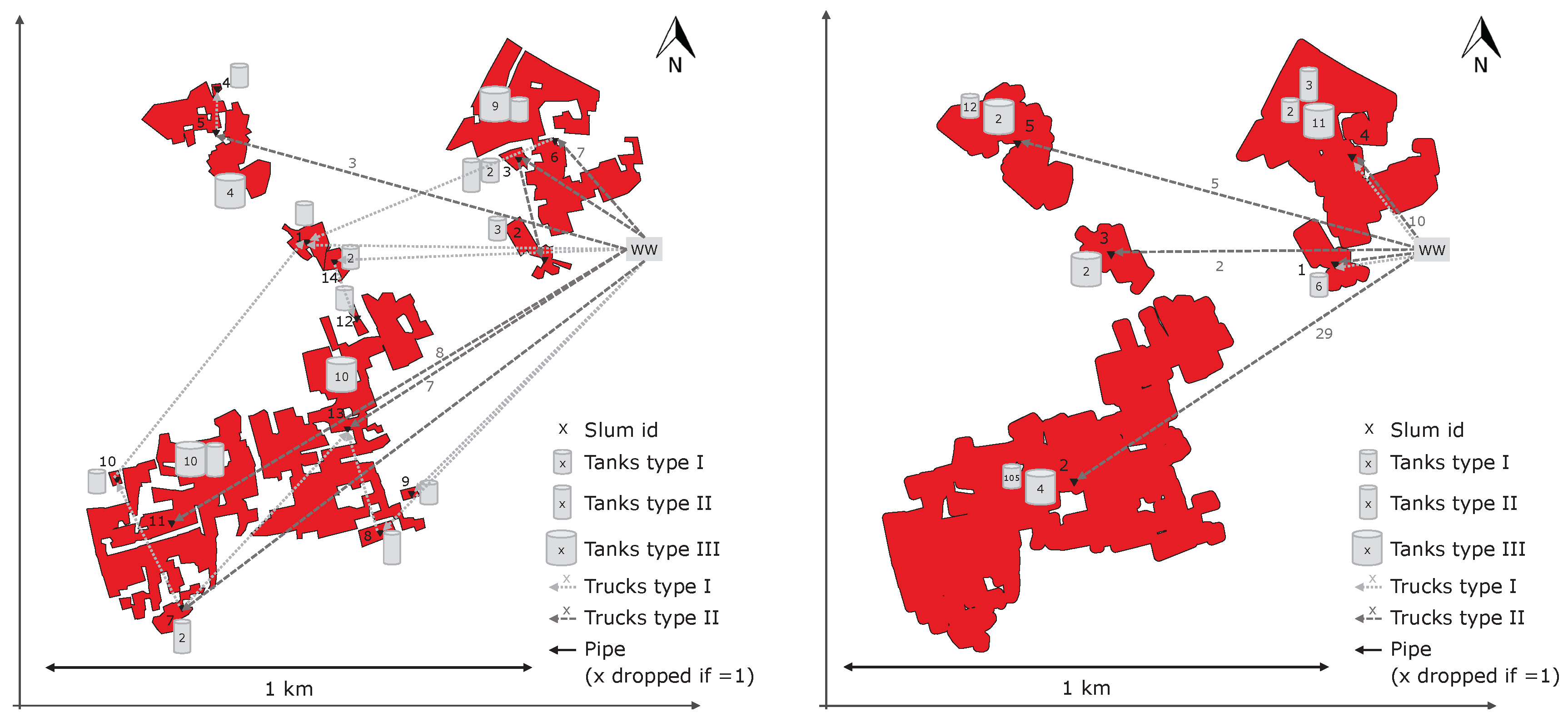
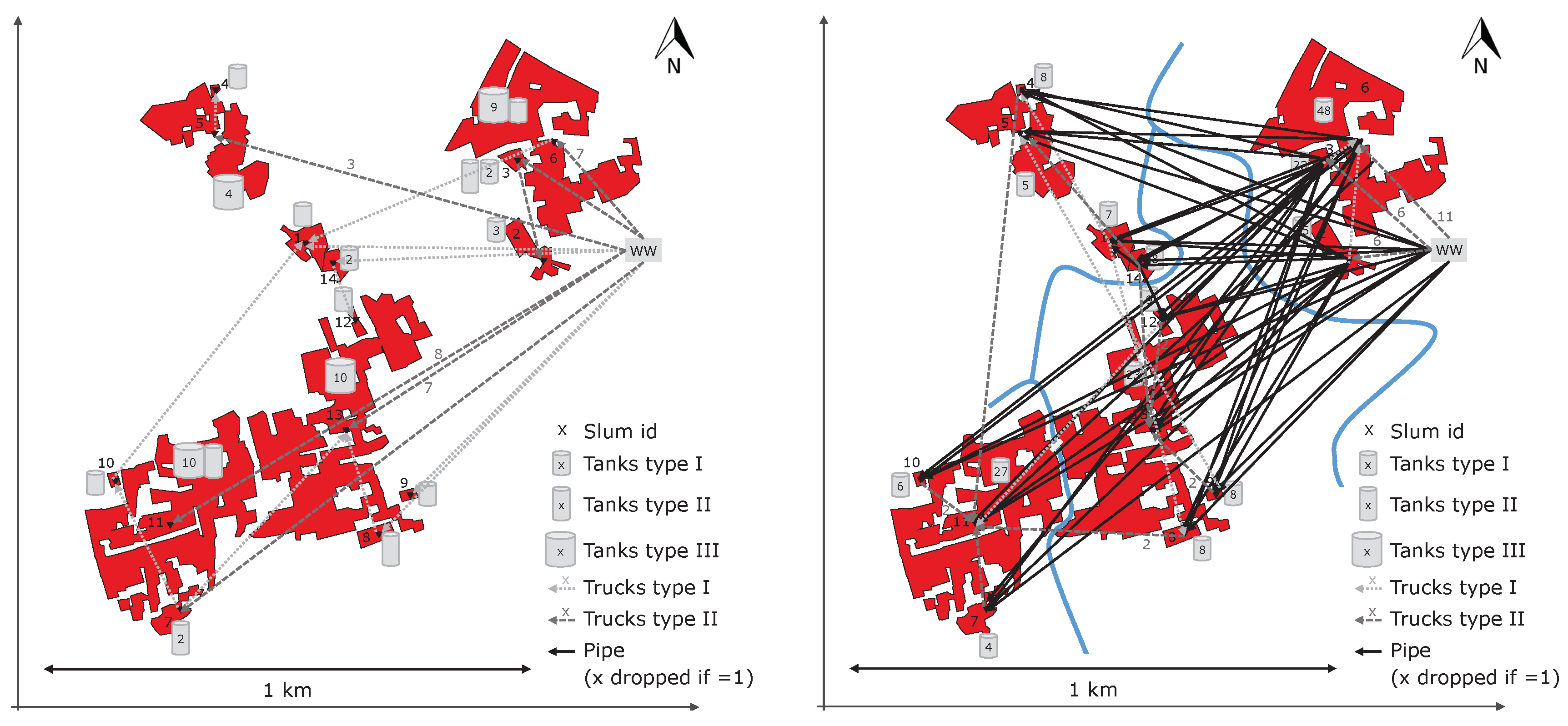
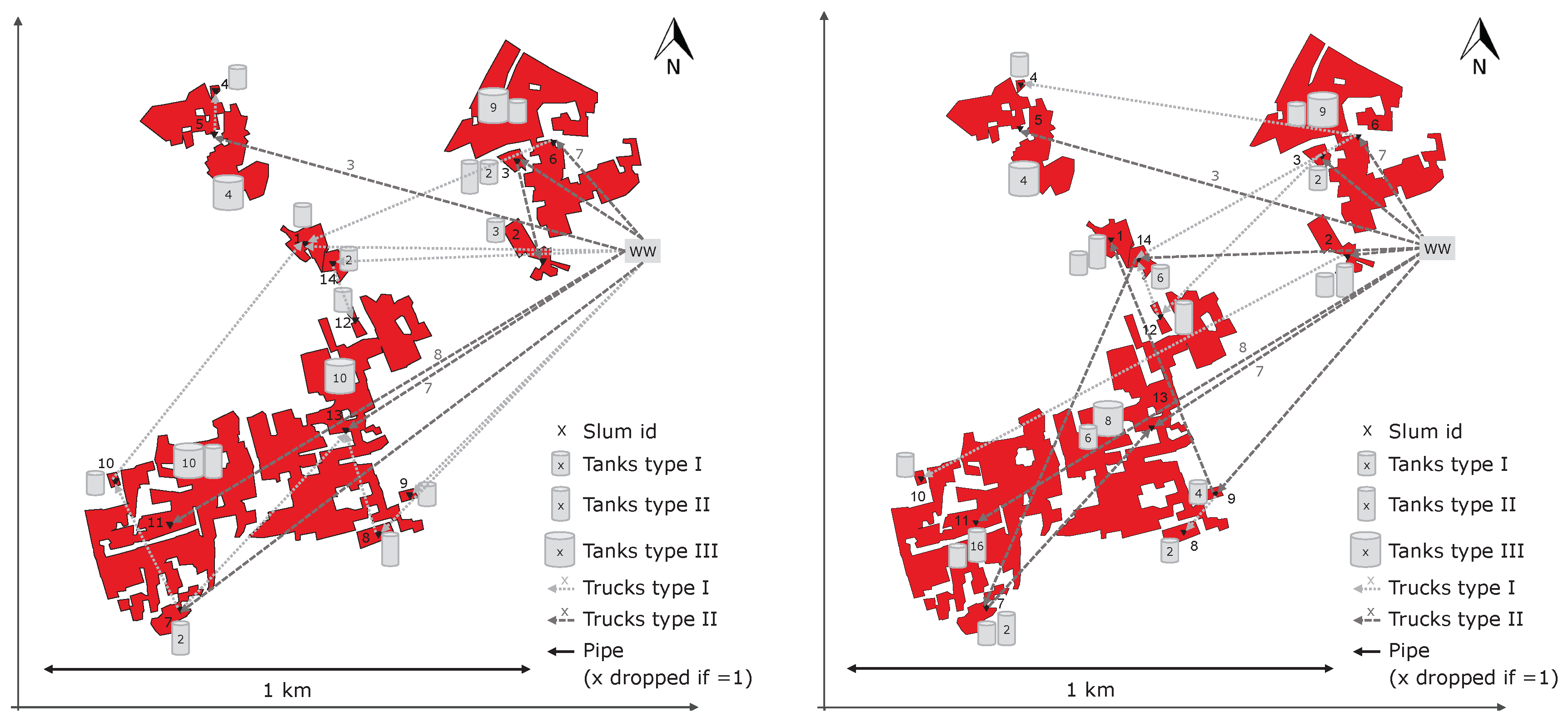
| Parameter | Description | Unit | Parameter | Description | Unit |
|---|---|---|---|---|---|
| Factors from pipe price estimation (in Portugal) | Distance between slums i and j | ||||
| Pump efficiency | Period for calculation | ||||
| Resistance number depending on the diameter of the pipe | Proportion of time of a day in which the pipe is used | ||||
| Factor with which aerial distance between slums is multiplied to estimate route | Factor representing the difference in price level between Portugal and the target country | ||||
| Density of water | Fuel need for truck type k | ||||
| Price of fuel | d | Diameter of pipe | |||
| Typical energy prices | Volume flow on pipe from slum i to j | ||||
| Price for a pump required for a pipe with diameter d | € | Price to buy a truck of type k | € | ||
| Wage of a truck driver | u | flow velocity |
© 2018 by the authors. Licensee MDPI, Basel, Switzerland. This article is an open access article distributed under the terms and conditions of the Creative Commons Attribution (CC BY) license (http://creativecommons.org/licenses/by/4.0/).
Share and Cite
Rausch, L.; Friesen, J.; Altherr, L.C.; Meck, M.; Pelz, P.F. A Holistic Concept to Design Optimal Water Supply Infrastructures for Informal Settlements Using Remote Sensing Data. Remote Sens. 2018, 10, 216. https://doi.org/10.3390/rs10020216
Rausch L, Friesen J, Altherr LC, Meck M, Pelz PF. A Holistic Concept to Design Optimal Water Supply Infrastructures for Informal Settlements Using Remote Sensing Data. Remote Sensing. 2018; 10(2):216. https://doi.org/10.3390/rs10020216
Chicago/Turabian StyleRausch, Lea, John Friesen, Lena C. Altherr, Marvin Meck, and Peter F. Pelz. 2018. "A Holistic Concept to Design Optimal Water Supply Infrastructures for Informal Settlements Using Remote Sensing Data" Remote Sensing 10, no. 2: 216. https://doi.org/10.3390/rs10020216





